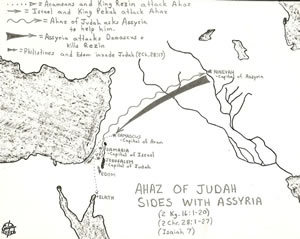| |

|
March 26 - Morning
"When the ark of the Lord had been in Philistine territory seven months, the Philistines called for
the priests and the diviners and said,
'What shall we do with the ark of the Lord?
Tell us how we should send it back to its place.'...
The Philistines asked,
'What guilt offering should we send to him?'
They replied,
'Five gold tumors and five gold rats, according to the number of the Philistine rulers, because the same plague has struck both you and your rulers. Make models of the tumors and of the rats that are destroying the country, and give glory to Israel’s god. Perhaps he will lift his hand from you and your gods and your land. Why do you harden your hearts as the Egyptians and Pharaoh did? When Israel’s god dealt harshly with them, did they not send the Israelites out so they could go on their way?...but keep watching it. If it goes up to its own territory, toward Beth Shemesh, then the Lord has brought this great disaster on us. But if it does not, then we will know that it was not his hand that struck us but that it happened to us by chance.' "
- First Samuel 6:1-2, 4-6, 9 |
 |
|
| The Ark Plagues Philistia |
|
|
While the Ark of the Lord was passed around among the five Philistine cities for seven months the people were plagued by tumors and rats which produced, it appears, something similar to the bubonic plague. The word for “plague” is maggepah, which is the same word used of the Egyptian plagues in Exodus 9:14. The Philistines had seen their god Dagon struck just like Pharaoh had seen his gods struck. And, just as Pharaoh hardened his heart, the Philistines rejected the sign of Dagon’s falling and his decapitation, and the Philistines hardened their hearts. The same type of plague that destroyed Egypt began to destroy the Philistines, who decided, after seven months, to send Israel’s God back to Israel.
As was the custom of the day they made offerings, or donations, to the god, in this case, to the Lord, that they felt were pleasing to him and would honor him. Since the Philistines had known the Lord as the God of tumors and rats, they honored him with five golden tumors and five golden rats. They sent the Ark back to Israel on a cart drawn by two cows who have never been yoked and whose calves had been taken from them. Amazingly, the two untrained cows left their calves behind and pulled the cart containing the Ark of the Covenant out of the land of the Philistines, through the Sorek Valley to the Levitical city of Beth Shemesh in Israel.
When the Philistines saw this they knew they had been struck by the hand of the Great God of Israel. |
|
 |
| "Failure to guard your heart will result in the corruption of your soul." - Galyn Wiemers |
 |
The Easter Conflict
In the apostolic churches in Asia the date of the Easter celebration was in agreement with the Passover, but in Rome the Latin church wanted to celebrate the crucifixion on a Friday and the resurrection on a Sunday. This became a source of contention among the churches.
• 150-155 AD, Smyrna Bishop Polycarp visited Rome Bishop Anicetus. The issue came up, and was not resolved, but Polycarp departed in peace saying this is how he celebrated Easter with the Apostle John.
• 170 AD, the same controversy developed in Laodicea but was dealt with peacefully.
• 190-194 AD, Rome Bishop Victor required the Asian churches to abandon their
Easter practices. The new Ephesian Bishop Polycrates appealed with a letter
which is still in existence today. Victor wouldn't listen, called them heretics,
excommunicated them and would not send them communion elements. Irenaeus intereceded by quoting Colossians 2:16:
"The apostles have ordered that we should, 'Judge no one in meat or in drink, or in respect to a feast day or a new moon or a Sabbath day.' "
Asia Minor's views:
- Followed Jewish chronology
- Followed the Apostle John and Philip's example
- They celebrated the Christian form of the Passover on Nisan 14 and at the end of the day they broke their Easter fast with communion and the
Love Feast.
Roman Church view:
- Appealed to early custom of celebrating Jesus death on a Friday
- Celebrated Easter on a Sunday after March full moon
- Most churches did this
-The Roman practice created an entire holy week of fasting to recall Lord's suffering.
- The Problem to the Roman Church was that part of the universal church was celebrating and feasting the Lord's resurrection while another part was still fasting his death.
The Nicean Council of 325 established this practice:
"Easter should be celebrated on the first Sunday after the first full moon succeeding the vernal equinox (March 21). If the full moon occurs on a
Sunday, Easter-day is the Sunday after. Easter can be anywhere from March
22 to April 25."
- Nicean Council of 325
The last trace of the "heretics" from Asia was seen in the 500's AD. |
|
| |
|
|
| |
|
 |
 |
 |
 |
Employment |
Generosity |
Race Relations |
Cameroon |
|
|
| |
 |
 |
 |
 |
| The Citadel as viewed from outside the Joppa Gate and above the Hinnom Valley. This was the site of Herod's palace in Jerusalem and also the fortress of the Maccabees. Since Bible times this fortress has been used by the Romans, the Muslims, the Crusaders, etc. (click on image for larger size) |
Details of King Ahaz of Judah siding with Assyria in disobedience to God's word to him through Isaiah in Isaiah 7. Text of Scripture is 2 Kings 16:1-20 and 2 Chronicles 28:1-27. (click on image for larger size) |
| |
|
| Details and Explanation of Sets & Reps Devotional System Here |
 |
|
|
| |
| |
| |
| Reps & Sets is a daily Bible devotional for Christians from Generation Word Bible Teaching used each morning and evening. |
| |
|